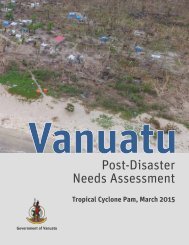Fiji
yqgk302EGjo
yqgk302EGjo
Create successful ePaper yourself
Turn your PDF publications into a flip-book with our unique Google optimized e-Paper software.
FIJI Post-Disaster Needs Assessment<br />
Making use of data available from FBOS 84 and data derived from adjusted modelling undertaken by the 2010 Pacific<br />
Catastrophic Risk Assessment and Financing Initiative (PCRAFI), the population of 182,015 households was calculated to<br />
be living in a total housing stock of some 146,292 units in 2015, indicating a country-wide occupancy rate of around 1.3<br />
households per building although this was not uniform throughout the country. In a number of provinces in the Northern<br />
and Eastern Divisions which are experiencing population out-migration, occupancy rates were below 1, whereas in<br />
the faster growing Central and Western Divisions, and particularly in the Suva-Nausori and Nadi-Ba urban corridors,<br />
occupancy rates were higher at 1.45 per housing unit, indicating that the supply of affordable housing has not kept up with<br />
population growth. 85 In response to unmet demand and opportunities for supplementing household incomes, according to<br />
the 2008/2009 HIES, around one in three families in urban areas rented out at least one room in their house and, deriving<br />
supplementary income from this activity.<br />
The country’s land on which housing is built is codified into three main tenure forms, namely iTaukei (native) land<br />
(87 percent), state land (6 percent) and freehold (7 percent). According to the 2011 National Housing Policy, around 63<br />
percent of households lived on freehold or leasehold land and a further 29 percent lived in village settlements where they<br />
are afforded secure tenure through their community status (Ministry of Local Government, Urban Development, Housing<br />
and Environment, 2011). The high overall security of tenure is reflected in both the quality of the housing stock and median<br />
house size. Table 44 shows the wall materials of the pre-Winston housing stock by division.<br />
Table 44: Housing Stock by Type of Wall Material and Distribution by Division<br />
Division<br />
Concrete<br />
Timber frame/<br />
Wood<br />
Timber frame/<br />
Tin iron<br />
Bure<br />
Makeshift/<br />
Other<br />
Total<br />
No. Units<br />
Central 25,092 12,102 17,676 672 518 56,060<br />
Eastern 2,901 4,691 3,333 207 83 11,215<br />
Northern 2,564 7,122 5,683 539 379 16,287<br />
Western 27,271 9,600 23,660 1,409 790 62,730<br />
Total 57,828 33,515 50,352 2,827 1,770 146,292<br />
Source: MLGHE<br />
The above table indicates that approximately 57 percent of houses consist of reasonably well constructed timber frame<br />
with either wood or tin iron cladding, and a further 40 percent of houses are made of concrete/masonry construction.<br />
Over the years, the use of traditional bure housing has given way to concrete and fixed timber frame construction, which<br />
lends itself to easier fitting of plumbing and electricity supplies. The <strong>Fiji</strong>an vernacular bure house type currently constitutes<br />
only 3 percent of the overall housing stock, although accounting for 10 percent of houses in the Northern Division and<br />
7 percent in the Eastern Division. Drawing on the digitized building footprints collated under PCRAFI, the median floor<br />
area of <strong>Fiji</strong>’s houses are large, around 80m 2 (concrete) and 60m 2 (timber frame), reflecting a mature housing stock that<br />
has been incrementally consolidated by home owners over a number of years. According to a number of construction<br />
industry experts consulted during the course of the PDNA, ‘like-for-like’ house replacement costs would be in the order of<br />
F$750/m 2 for concrete houses and F$650/m 2 for timber frame housing, equivalent to a median house value of F$60,000<br />
(concrete) to F$40,000 (timber frame).<br />
However, the housing characteristics for the estimated 15 percent of the population living in some 240 informal settlements<br />
(primarily located in and around the Lami-Suva-Nausori and Nadi-Lautoka-Ba urban corridors and in Labasa town) point<br />
to less permanent structures. The settlements are far from homogenous, but based on a 2015 survey of 31 informal<br />
settlements, 86 only 10 percent of houses were concrete and the remaining 90 percent were timber frame and tin iron of<br />
varying construction quality and, in many cases, built using recycled materials. The lower quality overall in comparison<br />
to the wider housing stock is likely to reflect variables, such as a higher incidence of poverty found within many informal<br />
settlements and uncertainty regarding tenure security, in particular in those settlements located on privately-owned land. 87<br />
Within the constraints of available statistics, determining the proportion of women headed households who are home or<br />
land owners is not possible. While women’s participation in most types of economic activities is not restricted in <strong>Fiji</strong>, iTaukei<br />
women have limited rights to inherit customary land or to own immovable property and, similarly, patriarchal inheritance<br />
preferences tend to dominate the freehold and leasehold markets. However, under Section 35 of the Bill of Rights in the<br />
84<br />
FBOS, 2011; FBOS, 2007.<br />
85<br />
The concentration of the housing deficit in urban rather than rural areas is also reflected in the fact that although urban areas account<br />
for 51 percent of the population, they account for only 46.3 percent of the housing stock and, by corollary, the 49 percent of the population<br />
which is rural occupies 53.7 percent of the housing stock.<br />
86<br />
Informal settlement survey carried out by the People’s Community Network, November 2015.<br />
87<br />
Informal settlements have grown on all categories of land in <strong>Fiji</strong>. The settlements on state land (including settlements established 40 or<br />
more years ago) tend to be located within town boundaries; settlements on iTaukei land are found within urban areas and also in less<br />
regulated peri-urban areas; and a smaller number of settlements are on freehold land.<br />
Tropical Cyclone Winston, February 20, 2016<br />
73



